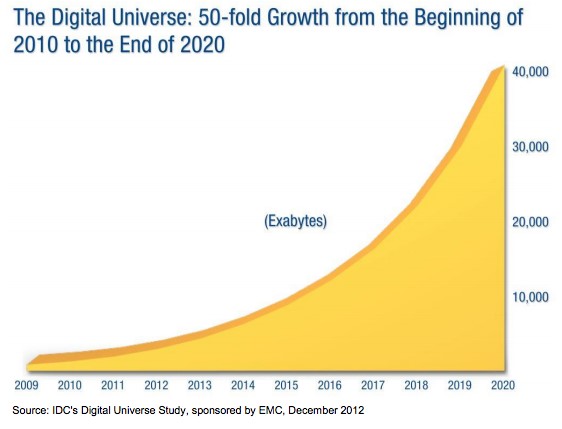Datafication...an outlook at our data assets!

Datafication (also referred as Datafy) is a modern technological trend turning many aspects of our life into computerised data and transforming this information into new forms of value, says Wikipedia. Today all aspects of our life is surrounded by multitude of technologies that generate data.
General perception that might be closer to reality is that everyone is overwhelmed with data, making the ability to store, process, analyze, normalize, transform and consume the insights, and further act upon that insight remains a primary concern. For large-scale, multi-national organizations and those in heavily regulated industries - such as finance, healthcare, or those covering multiple industry verticals - the situation becomes even more complex and challenging due to data integrity, repudiation and security requirements.
Datafication can be conceptualised in detail via three innovative concepts that allow the logic of value creation to be rethought via dematerialisation, liquification and density. (as per Richard Normann, 2001) The ability to separate the informational aspect of an data asset/resource and its use in context from the physical world is dematerialization ( Read, Dmat) as a next logical step after Dmat stage, data can be normalized, transformed and migrated digitally allowing resources and algorithms / application sets that were closely linked physically to be ungroups and 're-grouped' ( better say, re-organized) thus called Liquification, finally optimization or (re)combination of information resources ( Read, matured data sets, algorithms and transactional APIs etc), mobilised for a particular context or outcome, at a given time and place is density, a final outcome of the value creation process of datafication. In this school of thinking, offerings are the input to (rather than the output of) the value creation process, which is primarily defined from the perspective of value-in-use which itself is dynamic interplay of the value creation context of today (driven by BI/AI etc) as denser reconfiguration of resources into co-created value patterns, insights and a greater (more focussed and individualised) variety of patterns thereof.
Now Adding more complexity into this is escalating data volume concerns that are rampant in the Internet of Things (IoT) Age, during which growth of data is exceeding the capacity of traditional computing and much beyond the trajectory of emerging technologies as well to some extent. Individuals, emerging technologies such as machine-generated data is experiencing exponential growth rate at ten times in two years than traditional business data, and machine data is increasing even more rapidly at 50x the growth rate which is phenomenal. Connecting machines, sensors, and actuators to computing systems enables a large degree of data sets powering todays process automation. For example, fleet management systems enable automatic logging of driving parameters such as hours in motion, removing the need for drivers to manually submit this information. Automation facilitates dramatically larger scales of data utilization as well. For example, jet aircraft engines typically produce several terabytes of data per flight on operating parameters. Proactively monitoring this data feed enables faster resolution times in instances of performance faults and minimizes unnecessary maintenance services. It is imperative for an organization to decide as to how they will engage, operate and leverage their data sets and adopt enterprise-grade data strategy are well positioned to optimize their technology investments and optimize their cost structures.
To bring a different context to this discussion we can classify the data assets in five key tenets...
Data as Record : Invoices, payment receipts, warranty cards, account statements, insurance policies etc forming an important piece of record, must be preserved and entails integrity and availability of such data, storage required is large and stale due to the volume and incremental growth of this data, WORM ( write once read many) types. Focus on storage and retention, driven mostly by policies, regulatory / statutory compliance.
Data as Communication : Emails, chats, presentations, interactions, etc that facilitates communication by and between stakeholders relatively insignificant once used and acknowledges barring few record keeping legal or statutory needs and entails faster exchange of data and repudiation of the sender and receiver. Focus on connectivity and delivery of the content , driven mostly by users and interactions
Data as Efficiency > IoT, Sensors, GPS Devices, online shopping catalogues and carts, maps, locations etc that facilitate the relevant data points required for quick decision making and "Call for Action" relate to constancy of purpose if momentarily, this obviously entails real-time collection and processing at the Edge ( processing at point of collection) and further reaches to AI/ML engines, big data hubs for insights , predictive and prescriptive usage thereof. Driven mostly by innovation and technology transformation
Data as Currency - Electronic wallets, cryptocurrencies, IMPS,RTGS, UPI transactions are mode and means of digital economy and getting integrated with mobile and on the move kind of instant enablement. The quantum of these from the technology innovations and global markets lead the curve today. These entail validations, integrated or connected systems, confidentiality and integrity of transactions and set of records that needs to be encrypted and fast enough on processing and connectivity to mobilize the purpose. Focus here is any device, anytime processing and end to end encryption ( read, data in motion and data at rest principles) again driven by digital transformation and world economics
Data as Metadata ( Data of Data) - The data about data is important for enablement of analytics and mostly relevant to all above tenets, the metadata ensures we have a comprehensive understanding about data and purpose of the value that this data brings to the ecosystem where it is deployed, the metadata rides along with 'data' and can help confirm the focus areas such as integrity, encryption, repudiation, classification, origin, alterations, relevance etc for the algorithms and or business logic that data science plays around with in this digital transformation era... driven by need ( rather urge) for control and automation desires of digital transformation and innovation curve.

To drive this point further we need to acknowledge the reality where locations, interactions and words are becoming data... for example social media companies are building their entire data strategies based on interactions, Facebook Datafy our relationships, twitter Datafy our emotions and thoughts, Instagram Datafy our outlook at looking at the world whereas LinkedIn Datafy our professional experience and skills. Google, Apple Datafy our location for tracking people and objects and Uber and OLA are maximizing their resources revolving around the same. Google books Datafy word and re-catalogue books and contents for faster referencing and retrieval, thus context wherein data strategy is applied is changing the business models and determines the value it brings to the world.
Such a strategies treats data as an asset from which valuable insights are derived and used to gain a competitive advantage by being integrated into business operations, aligning operational decisions to the systematic (and automated) interpretation of data advancing their digital transformation journey by treating data as a corporate asset and insights as intellectual property (IP). additional enterprise data architects.
Simply put, data strategy is a common reference of methods, services, architectures, usage patterns and procedures for acquiring, integrating, storing, securing, managing, monitoring, analysing, consuming and operationalizing data. This can be achieved via few drivers such as Unification of perspectives of business and technology, Alignment of vision and guidance on data assets and insights, key metrics and success criteria across the enterprise. And finally reduction of technology debt, since existing investment in legacy technology that may be providing limited business value in relation to cost, performance or quality needs, or is hindering the adoption of innovative technology or business practices. A good data strategy takes into account current state of the legacy data environments and operations and transforms it via applying innovation and emerging technologies such as bigdata, Artificial intelligence, Machine Learning in adaptive manner with minimal disruption to ongoing business operations.
Tenets of winning data strategy
To ensure that a data strategy incorporates the full scope necessary to provide enterprise-wide guidance, organizations should include the following foundational few fundamental components such as Semantics, Goals & Vision, Strategic Principles, Current state, Governance Model, Data management guidance (for data topics, Metadata, Stewardship etc), Reference Architecture ( covering but not limited to Architectural principles, domain and functional Model, Data usage patterns, design patterns, Functional Matrix and Tools mapping / rationalization) and finally a Solution library or repository ( of Logical solution Models, designs, historical or prebuilt Models / Codes and IPs, Third party Solutions etc.

Conclusion, The "Datafication" analogy presented here based on the concept of verbiage similar to the 19th century and early 20th century's "electrification" transformation is not correlated in every respect, but the analogy does capture the core idea of isolated, complex, and limited systems transforming into a pervasive utility. Electrification had a fundamental impact on most industries and markets in the 20th century.
Datafication has become common and continues to touch peoples' lives and gaining more widespread traction, the evolution and fundamentals of new frameworks for understanding is becoming increasingly necessary. In addition, datafication requires a significant re-assessment of several areas of legacy methods of operation. The attempt was to introduce the concept and strategic tenets of datafication that are emerging alongside traditional supply and value chains and key aspects that needs to take into account and effectively implement datafication or strategies thereof.
Compiled from various online sources such as Wikipedia, IDC, Google Books. DXC blog and other tech forums..
January 24th 2018